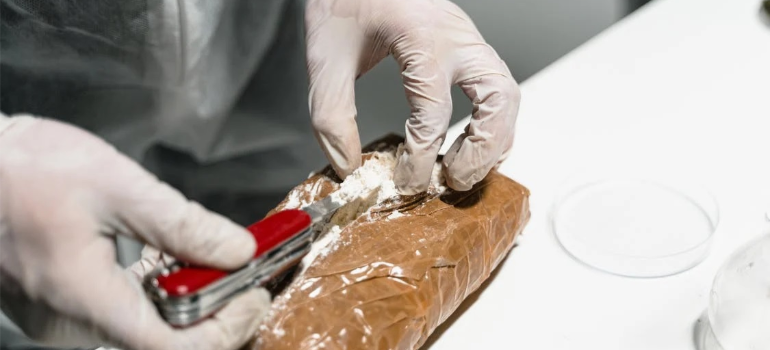Cocaine may be one of the most infamous drugs in the US and across the world. Whether it was 1983’s Scarface that truly thrust it into the public consciousness or not, little has changed since. Cocaine remains an incredibly addictive illicit drug, which sees use by various demographics and occupations nationwide. As such, people from all walks of life prepare for a cocaine detox program in West Virginia every year. As addiction treatment pioneers, we at Harmony Ridge Recovery and our West Virginia treatment center are here to help. In this article, we’ll explore cocaine, provide a reference point for cocaine rehab timelines, and outline key cocaine rehab criteria.
Prepare for a Cocaine Detox Program in West Virginia; Exploring Cocaine
First and foremost, let us begin this exploration with a deeper look into cocaine itself. Doing so will hopefully offer a fuller perspective on cocaine addiction rehab, from its needs to its duration and more.

What Is Cocaine?
Cocaine is a powerful and highly addictive stimulant drug. It is made from the Coca plant, scientifically “Erythroxylon coca”, which produces the psychoactive alkaloid cocaine.
Coca plants are native to western South America, where Coca leaves have seen ample historical use. Their name derives from the Greek “erythron” and “xylon”, meaning “red” and “wood,” respectively – as the plants are easily recognizable by their stems’ reddish hue and their red berries.
Coca leaves and purified cocaine have both seen much medical use. The latter was often the main active ingredient in painkillers in the 1900s before its addictive qualities were properly understood. Perhaps most famously, Coca-Cola products would use coca leaf extract from 1885 until 1903.
Today cocaine still has some limited medical uses, despite its infamy as an illicit recreational drug. In the US, it is a Schedule II drug, allowing doctors to administer it – typically for local anesthesia. Still, it is treated with utmost care as it is highly addictive and has massive potential for abuse.
If you’d like to learn more about cocaine as you prepare for a cocaine detox program in West Virginia, please read on. Alternatively, you can also explore NIDA’s other resources.
How Does Cocaine Work?
As a stimulant, cocaine directly influences the brain. It increases the levels of the natural neurotransmitter dopamine, specifically in brain circuits related to movement and reward. Because of this function, prolonged use has increasingly adverse effects as the user’s body adapts to it.
For a more specific explanation of its function, we may cite NIDA’s explanation:
“Normally, dopamine recycles back into the cell that released it, shutting off the signal between nerve cells. However, cocaine prevents dopamine from being recycled, causing large amounts to build up in the space between two nerve cells, stopping their normal communication.”
It is this function that produces cocaine’s powerful euphoric effects and also results in swift withdrawal symptoms. NIDA continues to explain how cocaine use soon kindles addiction:
“This flood of dopamine in the brain’s reward circuit strongly reinforces drug-taking behaviors. With continued drug use, the reward circuit may adapt, becoming less sensitive to the drug. As a result, people take stronger and more frequent doses in an attempt to feel the same high, and to obtain relief from withdrawal.”

Effects Of Cocaine And Short-Term Effects On Health
On the subject of cocaine’s effects, these are indeed quite powerful. As you can imagine from the way it functions, cocaine’s stimulating effects include:
- Extreme euphoria; feelings of happiness and energy
- Increased sensitivity to sights, sounds, and touch
- Heightened mental alertness and focus
However, one should prepare for a cocaine detox program in West Virginia after prolonged use. Short-term effects can be unpleasurable as well, including:
- Irritability
- Difficulty performing mental tasks
- Paranoia
In addition, cocaine use can have immediate adverse effects on health, including:
- Raised body temperature and blood pressure due to constricted blood vessels
- Fast or irregular heartbeat, sometimes introducing the risk of heart attacks
- Restlessness and increased irritability
- Nausea and sometimes vomiting
- Tremors and muscle twitches, which may endanger heavy machinery operators
Finally, even those involved with non-needle cocaine use increase their chances of contracting HIV, Hepatitis C (HCV), and other STDs. NIDA finds this is because “[d]rug intoxication and addiction can compromise judgment and decision-making”. Once contracted, continued use of cocaine even accelerates HIV infections:
“Studies that examine patterns of HIV infection and progression have demonstrated that cocaine use accelerates HIV infection. Research indicates that cocaine impairs immune cell function, promotes replication of the HIV virus, and potentiates the damaging effects of HIV on different types of cells in the brain and spinal cord, resulting in further damage.”

Cocaine Use and Misuse
Cocaine can be consumed in various different ways and often sees combinations with other drugs as well. It’s for these reasons why cocaine use should typically have one prepare for a cocaine detox program in West Virginia; cocaine use is rarely casual and often escalates very quickly.
As regards use, addicted individuals typically use cocaine in the following ways:
- Oral use. Cocaine is typically consumed orally by being rubbed on the gums.
- Snorting. Another common use of cocaine is via snorting.
- Inhalation. In its rock crystal form, “Crack” cocaine can be heated so one can inhale the vapors. Some may also sprinkle Crack on tobacco or marijuana and smoke it.
- Injection. Finally, one can dissolve cocaine in water and inject it.
Most of these methods make cocaine’s effects kick in almost immediately, particularly by snorting and injecting it. However, all of these methods also come with a severe potential for misuse:
- Overdosing. Some consumption methods obscure dosages, making overdosing on toxic amounts of cocaine likely. The CDC finds that overdose deaths in the US continue to increase, with cocaine playing a significant role.
- Drug combinations. Consumption through inhalation or injection, mostly but not exclusively, invites combinations with other drugs. This, too, introduces serious health risks from combined drug effects.
- Extreme mental health impact. Finally, especially in combination, cocaine use can cause severe paranoia. Especially in combination with psychotropic drugs, it can cause long and dangerous episodes of hallucinations.
Cocaine misuse does vary significantly, of course, and so do exact adverse effects. Cocaine’s euphoric effects may often mask the latter for a time until dependence sets in.
Long-Term Impact On Health
But before discussing dependence and addiction to help you prepare for a cocaine detox program in West Virginia, we should note the above are only immediate and short-term effects of cocaine use. Addiction also comes with both long-term and use-specific effects.
As regards long-term health effects, prolonged use can cause such stronger symptoms as:
- Intense and long-lasting headaches
- Convulsions and seizures
- Heart disease, often a precursor to heart attacks and strokes
- Intense mood swings and prolonged irritability
- Lowered sex drive and libido, in contrast to short-term boosts after use
Additionally, different means of cocaine consumption also carry their own, often serious, health risks:
- Snorting cocaine can cause loss of smell and frequent nosebleeds, alongside problems with swallowing.
- Oral consumption of cocaine can, most notably, cause bowel decay due to reduced blood flow.
- Smoking cocaine comes with a plethora of respiratory health problems, including respiratory distress, persistent coughs, and asthma. Lung damage can also worsen the impact of such infections as pneumonia.
- Injecting cocaine intravenously may cause scarring or collapsed veins. More importantly, it significantly increases the risk of contracting bloodborne diseases like HIV and HCV, as we outlined above.
These, too, will vary quite significantly across different cases of addiction. However, cocaine addiction tends to take hold very quickly, and powerful withdrawal symptoms make quitting extremely hard.

Cocaine Dependence And Addiction
To quantify this, AAC’s DrugAbuse cites the Center for Substance Abuse Research (CSAR) to assert that cocaine is staggeringly addictive. In the case of crack cocaine specifically, it notes that users can become addicted after the very first use. This is exactly why conscious users should prepare for a cocaine detox program in West Virginia as early as possible.
This will, of course, vary across individuals and consumption methods, but cocaine still boasts incredibly addictive qualities. Because of the way it functions, as we outlined above, it physically kindles addiction. With few repeat uses, it quickly initiates the typical process of addiction:
- Tolerance. First, the body begins to adapt to the addictive substance. Euphoric effects diminish, and the user requires higher doses to achieve the same effects as before. In the case of cocaine, this may fuel binge consumption or drug combinations, increasing the risk of overdosing.
- Dependence. After tolerance settles in, the body begins to depend on the substance to continue to function. Withdrawal symptoms obstruct everyday activities and make the user obsess over their next dose.
- Addiction. With dependence and strong withdrawal symptoms preventing the user from quitting, addiction becomes apparent. The user becomes fixated on consuming the substance, often alienated from social circles and unable to function in everyday life.
The exact timeline from each phase to the next does tend to differ, naturally. Moreover, we strongly advise that you receive an addiction diagnosis from a professional; self-diagnosis can be very unreliable. Still, for informational purposes, we will also outline addiction criteria below.

Cocaine Withdrawal Symptoms And Post-Acute Withdrawal Symptom (PAWS)
Unfortunately, cocaine also comes with notable withdrawal symptoms. These include both physical symptoms and mental ones, often discouraging any attempts to quit using the drug.
As you prepare for a cocaine detox program in West Virginia, it’s vital to know you will have to face at least some of them. First, cocaine withdrawal can come with typical substance withdrawal symptoms, as AAC lists them:
- Dilated pupils
- Trembling and tremors
- Muscle pain or aches
- Hunger or loss of appetite
- Fatigue
- Sweating
- Irritability and agitation
- Depression
- Anxiety
- Nausea
- Vomiting
- Confusion
- Insomnia
- Paranoia
- Seizures
Then, WebMD notes the following as more typical or specific to cocaine:
- Depression
- Anxiety
- Fatigue
- Trouble concentrating
- Increased hunger
- Cravings
- Nightmares
- Chills, nerve pain, and muscle aches
Finally, after withdrawal symptoms recede, the possibility of Post-Acute Withdrawal Syndrome (PAWS) remains. Unfortunately, PAWS symptoms may trigger seemingly without warning or reason and may emerge up to some months after quitting. The University of California, Los Angeles (UCLA) identifies the following PAWS symptoms:
- Difficulty with cognitive tasks, such as learning, problem-solving, or memory recall
- Irritability
- Feelings of anxiety or panic
- Depressed mood
- Obsessive-compulsive behaviors
- Difficulty maintaining social relationships
- Craving originally abused substances
- Apathy or pessimism
- Disturbances in sleep patterns
- Increased sensitivity to stress
While such symptoms do vary significantly, they still present a challenge to most addicted individuals. Their severity and persistence typically make medication-assisted treatment (MAT) a necessity for a successful detox.
Prepare for a Cocaine Detox Program in West Virginia; The Roots Of Cocaine Addiction
Finally, before exploring the timeline of cocaine addiction treatment, here we may explore cocaine addiction more deeply. Specifically, we’ll briefly highlight differences among demographics, addiction criteria, and relapse rates. This information should hopefully help you prepare for a cocaine detox program in West Virginia with deeper insights.

Which Demographics Are More Prone To Cocaine Addiction?
First, cocaine specifically sees far smaller disparities among different demographics than one might expect. SAMHSA’s 2018 National Survey on Drug Use and Health (NSDUH) confirms this, reporting the following rates of cocaine addiction for persons aged 12 and older:
- White Americans – 2.1%
- Hispanic/Latino Americans – 1.9%
- American Indians and Alaskan Natives – 1.9%
- Black Americans – 1.8%
- Native Hawaiian and Other Pacific Islanders – 1.6%
- Asian Americans – 1.4%
That’s not to say these rates are universal and static across all settings, of course. For example, an NCBI study on “adult participants 18 years of age and older who reported cocaine and/or heroin use in the last 30 days” found different rates of self-report and different substance combination rates:
- “Among Blacks, 82% reported current cocaine use compared to 54% of Hispanics and 57% of Whites. […] A higher percentage of Blacks (84%) also reported alcohol use in the last month, compared to 62% of Hispanics and 68% of Whites.”
- “81% of Hispanics reported past month heroin use, and 71% of them were positive on hair analysis. [As] a group, Hispanics under-reported their use of cocaine [.]Chemical markers confirmed heroin as the drug of choice for Hispanics.”
- “For cocaine, 57% [of Whites] reported powder cocaine and 33% reported crack use in the last month[.] Whites had higher rates of heroin use but lower rates of cocaine use than Blacks, and lower rates of alcohol use in last month than Blacks but higher rates than Hispanics.”
Similarly, AddictionCenter finds that women report first use at a younger age than men and may become addicted more easily. Still, they find that “men are more likely to become addicts,” while women are more likely to relapse.
Substance Use Disorder Criteria
Nonetheless, before you begin to prepare for a cocaine detox program in West Virginia, you will want to confirm addiction. Professionals should always do so for you, but for informational purposes, we can cite DSM-5’s SUD criteria:
- Using more of a substance than intended or using it for longer than intended.
- Trying to cut down or stop using the substance but being unable to.
- Experiencing intense cravings or urges to use the substance.
- Needing more of the substance to get the desired effect.
- Developing withdrawal symptoms when not using the substance.
- Spending more time getting and using drugs and recovering from substance use.
- Neglecting responsibilities at home, work, or school because of substance use.
- Continuing to use even when it causes relationship problems.
- Giving up important or desirable social and recreational activities due to substance use.
- Using substances in risky settings that put the individual in danger.
- Continuing to use despite the substance causing physical and mental health problems.
The number of criteria an individual meets will then dictate the severity of their addiction:
- Two or three; mild SUD.
- Four or five; moderate SUD.
- Six or more; severe SUD.
Naturally, the severity of each case of addiction should always inform the levels of care an individual needs to recover.
Cocaine Addiction Relapse Rates
Finally, and unfortunately, relapse rates across all SUDs remain high – but the right treatment program can make all the difference. If relapse rates seem likely to stop you as you prepare for a cocaine detox program in West Virginia, please note the research that follows.
General SUD relapse rates do remain high:
- Citing the Journal of American Medical Association (JAMA), Caron finds relapse rates as high as 40 to 60%.
- NCBI research finds that “more than 85% of individuals relapse and return to drug use within 1 year of treatment”.
- A JAMA study reports that, for cocaine specifically, “23.5% [of patients] reported weekly cocaine use in the year following treatment [, and an] additional 18.0% had returned to another drug treatment program.”
Still, as you can see, exact rates vary considerably. This is because a robust aftercare program, thorough counseling, and continued community support can play a huge part in relapse. NCBI studies confirm this, finding a positive correlation between longer sober living home stays and lower relapse rates. Therefore, while no addiction treatment provider can fully prevent relapse, opting for science-backed and thorough addiction treatment will help significantly.

Prepare for a Cocaine Detox Program in West Virginia; Know Cocaine Addiction Treatment Timelines
With all of the above in mind, here we can provide a typical cocaine addiction treatment timeline. This will follow the typical program sequence, which tends to work for most cases, regardless of addiction severity. Still, please keep in mind that exact timelines will vary depending on addiction severity, co-occurring disorders, personal resolve and progress, and other factors.
#1 Medical Detox
As you prepare for a cocaine detox program in West Virginia, the first and toughest step tends to be medical detox. Regardless of addiction severity, except for the mildest cases, MAT is necessary to allow the body to detoxify. To achieve this, medical detox centers offer medication in a supervised, controlled medical environment.
During this stage, the individual has to manage withdrawal symptoms and cravings. Therefore, psychiatrists and other clinicians remain vigilant and ready to offer support as needed. Depending on the severity of the addiction, medical detox may take 1-2 weeks, rarely extending to 3.
#2 Inpatient Programs
Once medical detox concludes, the individual typically has to proceed to a residential/inpatient program. As it’s the core of most treatment programs for severe addictions, there are, thankfully, many options for inpatient drug rehab in WV.
As the name suggests, such programs have the individual reside at a medical facility. At this stage, 24/7 supervision is still necessary as the individual begins to adjust to abstinence. Pharmacotherapy may continue as needed, and individualized counseling typically remains the key focus. Inpatient programs tend to last for a month but may expand to 3 months or more, depending on the case.

#3 Partial Hospitalization Programs
When progress is slow due to addiction severity or other factors, the individual may not be fully ready to progress. Some cases may require some clinical services after inpatient treatment, which is the role Partial Hospitalization Programs (PHPs) cover.
While often optional, this is a notable step to cover if you are preparing for a cocaine detox program in West Virginia. PHPs are offered as a step-down service, bridging inpatient programs with outpatient ones. They entail some hours of clinical care per week and more hours of therapy per week than outpatient programs. Still, they allow the individual to stay at home and begin to reintegrate into everyday life. PHPs tend to last between two and four weeks but may extend depending on one’s needs.
#4 Outpatient Programs
Next come outpatient programs, which come in two main forms; Outpatient Programs (OPs) and Intensive Outpatient Programs (IOPs). Either can serve as the next step when the individual no longer needs clinical care and can stay at home. The two are functionally identical and mostly vary as regards treatment intensity and weekly therapy hours. For cocaine addiction specifically, any intensive outpatient program West Virginia treatment providers suggest tends to suffice.
During this step, the individual will typically begin to focus on group therapy as they reenter social life. At this stage, behavioral therapy comes into focus to tackle destructive patterns of behavior. Types of behavioral therapy for this stage tend to include:
- Cognitive Behavioral Therapy (CBT)
- Dialectic Behavior Therapy (DBT)
- Rational Emotive Behavior Therapy (REBT)
- Eye-Movement Desensitization and Reprocessing (EMDR)
An array of factors can make this stage’s duration vary, including mental health disorders that may require medication. Still, the typical IOP tends to last for 1 to 4 months.
Note Special Treatment Needs as you Prepare for a Cocaine Detox Program in West Virginia
Finally, as you prepare for a cocaine detox program in West Virginia, here we should outline some key rehab factors. We’ve mentioned manifold that treatment duration can vary significantly, depending on each case’s needs. So, before concluding, here we can explain just why.

#1 Mental Health Disorders And Dual Diagnosis
An initial key factor lies in the principle of dual diagnosis. In simple terms, a dual diagnosis finds that an SUD overlaps with at least one mental health disorder, typically including:
- Anxiety
- Bipolar disorder
- Depression
- Eating disorders
- Personality disorders and borderline personality disorders
- Schizophrenia
- Trauma
- Autism
- OCD
- ADHD
- PTSD
If this feels rare, it truly isn’t; if anything, it’s alarmingly common. NIDA finds that 37.9% of adults with SUDs also have mental illnesses. In addition, it finds that 18.2% of adults with a mental illness also have an SUD.

Needless to say, a dual diagnosis comes with unique challenges. Mental health disorders need to be identified and addressed alongside the SUD, which is often very challenging for the individual. Medication tends to be necessary in such cases, and treatment programs tend to last longer.
#2 Co-occurring SUDs
A second crucial factor lies in co-occurring SUDs or overlapping SUDs. This is also quite common, as we mentioned above, on drug combinations. ResearchGate data finds that SUDs often overlap, and cocaine addiction may co-occur with:
- A broader stimulants addiction beyond cocaine
- Heroin addiction, as the two often see combined use
- Marijuana addiction, typically overlapping with crack cocaine addiction
- Opiate addiction
- Meth addiction
- Fentanyl addiction
- Ambien addiction
- Barbiturates addiction
- Benzodiazepine addiction
As you prepare for a cocaine detox program in West Virginia, this factor warrants attention. That’s because all such overlaps present additional challenges of their own. The individual has more powerful withdrawal symptoms to deal with and may have suffered worse adverse effects on their health. As such, treatment may take longer, and relapse may be more likely.
#3 Additional Personal Needs
Finally, all else aside, every case of addiction comes with the individual’s own personal needs. Alongside the individual’s own resolve, these can include the unique needs of different demographics, occupations, and more. To illustrate this, consider how different some specialized rehab programs need to be:
- Rehab for professionals will often have to focus on the individual maintaining their occupation.
- Rehab for pregnant women needs to address distinctly unique mental and physical challenges.
- Intensive rehab for young adults will often focus on them maintaining their academic pursuits and healthy development.
- Rehab for seniors needs to account for the unique physical and mental needs of the elderly.
- Rehab for veterans commonly needs to deal with trauma and similar underlying mental health issues.
These, too, play a crucial role in the final treatment duration, methods and therapies involved, and more. There can be no one-size-fits-all approach to addiction treatment, after all, especially for drugs as powerful and addictive as cocaine.

Prepare for a Cocaine Detox Program in West Virginia With Harmony Ridge Recovery
In summary, cocaine is a notoriously addictive stimulant drug with powerful withdrawal symptoms. Because of its different means of consumption and drug combinations, it can present various serious risks to the user’s health. Unfortunately, cocaine is so addictive that dependence and cravings may begin within just a few uses.
If you or your loved ones struggle with cocaine addiction, we at Harmony Ridge Recovery are here to help. Our licensed, experienced staff has successfully treated this SUD manifold, and we’re confident we can personalize our cocaine treatment program to fully meet your unique needs. If you feel ready, call us today and take the first step on the journey to recovery.
References:
https://nida.nih.gov/research-topics/parents-educators/lesson-plans/mind-matters/cocaine
https://www.cdc.gov/nchs/pressroom/nchs_press_releases/2021/20211117.htm
https://drugabuse.com/drugs/cocaine/first-time/
https://americanaddictioncenters.org/withdrawal-timelines-treatments
https://www.webmd.com/mental-health/addiction/cocaine-use-and-its-effects#2
https://www.uclahealth.org/resnick/post-acute-withdrawal-syndrome
https://www.ncbi.nlm.nih.gov/pmc/articles/PMC1761118/
https://www.addictioncenter.com/addiction/differences-men-women/
https://dsm.psychiatryonline.org/doi/book/10.1176/appi.books.9780890425787
https://www.caron.org/blog/what-relapse-rates-really-tell-us
https://www.ncbi.nlm.nih.gov/pmc/articles/PMC3674771/
https://jamanetwork.com/journals/jamapsychiatry/fullarticle/1673778



